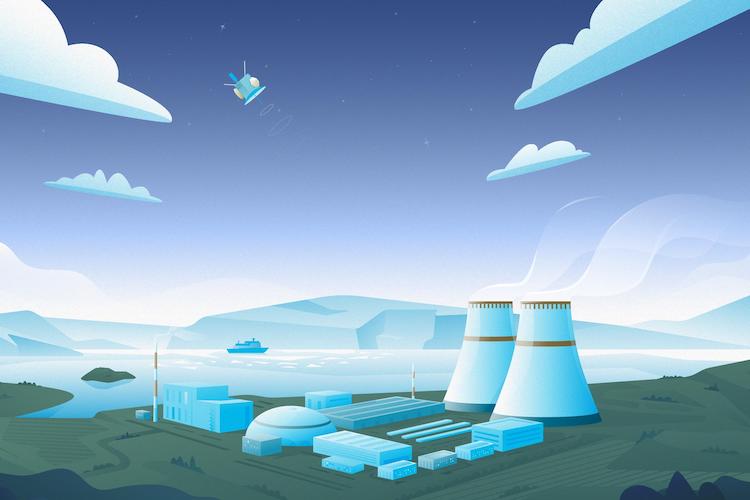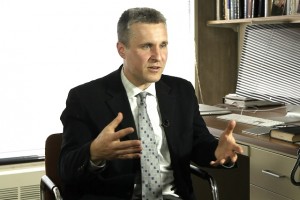Shock Electrodialysis
Chemical engineer Martin Z. Bazant on understanding dynamics at intermediate scale, "deionization shocks", and...

Chain reactions were developed independently in the 1930-s by two scientists Sir Hinshelwood from Oxford, UK, and Nikolay Nikolayevich Semyonov from the Institute for Chemical Physics in Moscow. They worked independently on this topic but came to the same conclusions and were jointly awarded the Nobel Prize for chemistry in 1956.
Chemical kinetics is a branch of physical chemistry that is involved with the study of rates and speed of chemical reactions and their mechanism. The first understanding of chemical reactions appeared in the 1880-s when Van Hoff and Arrhenius produced an empirical equation, which showed that the rate of any chemical reaction depended upon the collision rate between molecules (in the case of a bimolecular reaction) and on energy, which turned the activation energy. This was a negative exponential dependence on temperature, which means that if you heat the mixture up, the reaction goes faster. Heat flows in chemical reactions mean that you can either have an endothermic reaction, which means that you continuously have to supply energy for the reaction to take place because the energy of the products is higher than the energy of the reactants. Or there is an exothermic reaction, which means that heat is released in the chemical reaction.

Most people up until the late 1920-s believed that most chemical reactions were molecular. For example, if you have a molecule of hydrogen (two atoms of hydrogen joined together) and a molecule of chlorine (two chlorine atoms joined together), they react and produce hydrogen chloride (HCl). The former understanding was that you have some kind of molecular exchange during the collision. However, it became obvious that this mechanism was incorrect – there was a different way of how molecules reacted.
What actually happens is that you split the chlorine into two chlorine atoms. A chlorine atom then reacts with a molecule of hydrogen. It takes hydrogen from the molecule of hydrogen, leaving you with one molecule of hydrogen chlorine and a chlorine atom. The chlorine atom then reacts with a hydrogen molecule, pulls hydrogen from it, and, therefore, you have another molecule of hydrogen chloride being formed, but you regenerate the chlorine atom, which starts the whole process on. So, it just keeps on going till you run out of fuel, until you run out of reactive molecules. That is what a simple chain reaction looks like.
If the reaction is exothermic (produces heat), then it speeds up as you produce more and more product molecules (intermediate reactants). It can come to an explosion quite easily. It is important to understand that any exothermic reaction can be explosive. If you initiate the reaction and you don’t take away the heat by cooling the surface of the vessel on which you are doing the reaction, it will run away with itself and explode.
In that simple linear case, you start out with one reactive intermediate – an atom. What Hinshelwood and Semyonov realized was that there were many reactions where the reaction itself produced more radicals. It was called a branching chain reaction. You can start out with one initiating species. As the reaction progresses, it produces more and more reactive species. Then the reaction rate can run away with itself and produce an explosion. However, it is not a thermal explosion. It is caused by producing more and more reactive species in this branching chain.
The best example of such a reaction is the reaction of hydrogen molecules and oxygen molecules in the process of water production. Two molecules of hydrogen and one molecule of oxygen produce two molecules of water as the product. It is an extremely exothermic reaction; it produces a huge amount of heat, so it is usually explosive.
Two protagonists of the proposal of this branching chain were able to show how complex the mechanism is. It might seem that two molecules colliding with one molecule to produce two molecules of water would be a simple reaction. However, it is anything but. It involves 8 different propagating species, as many as 40 different reactions in this explosion, and is probably the prime example of a branching chain reaction.
The chain reaction, which most people would have heard of, is a nuclear chain reaction, where neutrons are produced in the fission of uranium-235. That initiates further fission of the uranium-235, and in an uncontrolled manner that would lead to an atomic explosion, like in the first atomic bomb. In a controlled manner, one can moderate how many neutrons are being produced by putting them in control rods. This process is the basis of nuclear power generation.
Two scientists communicated with each other, they knew what each other was doing, but they never really collaborated in terms of joining the experiences. Semyonov was more on the theoretical side, and Hinshelwood – was on the practical side, but they shared the Nobel Prize 50/50 because both contributed enormously to this project.
Semyonov and Hinshelwood went on to do many other things. Semyonov, by the 30-s, had been made a director of the Institute for Chemical Physics of the Academy of Sciences of the Soviet Union. In 1966 I was fortunate enough to spend a year at Semyonov’s Institute. I was invited by his deputy Victor Nikolayevich Kondratiev to spend a year with them. During that period, I met Semyonov on a couple of occasions. One of them is memorable – it was a New Year’s Eve party, where I drank vodka with him. And I was very proud to do it. I was a very young junior scientist with one of the giants of chemical kinetics. We used his textbook when I was an undergraduate, and we used Hinshelwood’s textbook, also. So, they were quite inseparable in terms of their contribution to science.
The understanding of the branching chain reaction, which both of them contributed to, led to a much better understanding of the explosive nature of some of the chemical reactions which occurred in the gas phase. It is an extremely important historical contribution to the understanding of science. It led to a fascination with chemical mechanisms, and it is true to say nowadays that very few chemical reactions, which take place, are actually molecular, which was thought to be the case almost universally in the 1920-s. Almost all chemical reactions occured through reactive intermediates rather than being a direct molecular combination. Therefore, they played a huge role in the development of their science.

Chemical engineer Martin Z. Bazant on understanding dynamics at intermediate scale, "deionization shocks", and...

Chemist Artem Oganov on Penrose’s patent, quasicrystals and connection between art, mathematics and chemistry

Inspired by nature, researchers come up with a new way to transmute the most abundant gas in the atmosphere un...